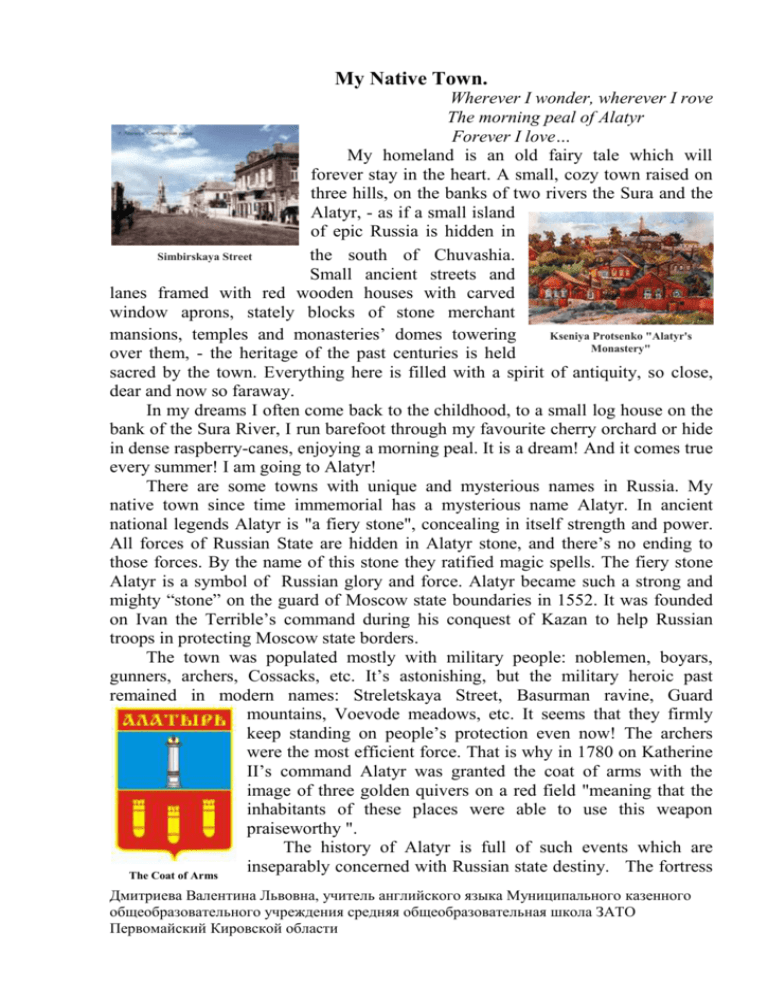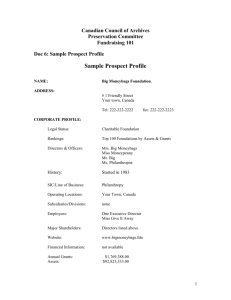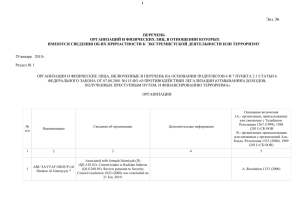My homeland is an old fairy tale which will forever stay in the heart
advertisement

My Native Town. Wherever I wonder, wherever I rove The morning peal of Alatyr Forever I love… My homeland is an old fairy tale which will forever stay in the heart. A small, cozy town raised on three hills, on the banks of two rivers the Sura and the Alatyr, - as if a small island of epic Russia is hidden in the south of Chuvashia. Simbirskaya Street Small ancient streets and lanes framed with red wooden houses with carved window aprons, stately blocks of stone merchant mansions, temples and monasteries’ domes towering Kseniya Protsenko "Alatyr's Monastery" over them, - the heritage of the past centuries is held sacred by the town. Everything here is filled with a spirit of antiquity, so close, dear and now so faraway. In my dreams I often come back to the childhood, to a small log house on the bank of the Sura River, I run barefoot through my favourite cherry orchard or hide in dense raspberry-canes, enjoying a morning peal. It is a dream! And it comes true every summer! I am going to Alatyr! There are some towns with unique and mysterious names in Russia. My native town since time immemorial has a mysterious name Alatyr. In ancient national legends Alatyr is "a fiery stone", concealing in itself strength and power. All forces of Russian State are hidden in Alatyr stone, and there’s no ending to those forces. By the name of this stone they ratified magic spells. The fiery stone Alatyr is a symbol of Russian glory and force. Alatyr became such a strong and mighty “stone” on the guard of Moscow state boundaries in 1552. It was founded on Ivan the Terrible’s command during his conquest of Kazan to help Russian troops in protecting Moscow state borders. The town was populated mostly with military people: noblemen, boyars, gunners, archers, Cossacks, etc. It’s astonishing, but the military heroic past remained in modern names: Streletskaya Street, Basurman ravine, Guard mountains, Voevode meadows, etc. It seems that they firmly keep standing on people’s protection even now! The archers were the most efficient force. That is why in 1780 on Katherine II’s command Alatyr was granted the coat of arms with the image of three golden quivers on a red field "meaning that the inhabitants of these places were able to use this weapon praiseworthy ". The history of Alatyr is full of such events which are inseparably concerned with Russian state destiny. The fortress The Coat of Arms Дмитриева Валентина Львовна, учитель английского языка Муниципального казенного общеобразовательного учреждения средняя общеобразовательная школа ЗАТО Первомайский Кировской области was ruined by the rebellious force of Stepan Razin’s troop, who reduced it to ashes in 1670. In 1774 the city met Yemelyan Pugachev who sturred up revolt among Alatyr’s peasantry. At the beginning of the XX century an important railway line was built through Alatyr and it played an important role as an industrial and trade centre, as it was the time of growth and development of the industrial enterprises. During the Great Patriotic War they accepted sanitary trains with the wounded, brought them back to life in town hospitals, worked sleeplessly and restlessly at the factories for the front and the Victory. In different times Alatyr was a part of Kazan, Nizhny Novgorod, Simbirsk provinces, and since 1925 it has been the territory of the Chuvash Republic. There is no city in our region where such number of churches and temples would be kept. Alatyr was proclaimed the Orthodox centre of Volga region by patriarch of Moscow and all Russia Alex II. The people really hold sacred their past, trying to revive Alatyr as the spiritual centre. The domes of the Holy Trinity Men’s Monastery (1558), Trinity Men's the Kiyevo-Nikolayevsky The Holy Monastery Women’s Convent (1639) tower majestically over the town. Ivan Predtechia's Cathedral (1703) and Nicolo-Znamensky Church (1770) are monuments of federal historical value. Among the remained monuments of spiritual culture and the history of XVII-XVIII centuries there is a memorial bell tower of The Kiyevo-Nikolayevsky Women's the Kazan (Pyatnitsky) Convent Church (1779) crowning the historical downtown, Krestovozdvizhensky church, the Theotokos Nativity Cathedral, Serafim Sarovsky's Cave temple, etc. Ivan Predtechia's Cathedral The cultural heritage of the city holds old Russian traditions of orthodox holidays: Christmas, the Epiphany, Easter, the Trinity, Saviour, - and folk customs: shrovetide, wedding celebrations, Sunday fair, etc., being an essential part of each inhabitant’s life. What is more… There are songs of our kind-hearted people – so simple Nicolo-Znamensky Chirch and sincere, so warm, so Russian… They fill you with new love towards both the people you live with and the nature. Дмитриева Валентина Львовна, учитель английского языка Муниципального казенного общеобразовательного учреждения средняя общеобразовательная школа ЗАТО Первомайский Кировской области The nature of Alatyr is unusually marvelous. In the North of the town there is a pine forest. Mighty pines and fir-trees stretch their heavy paws, inspiring with peace and confidence. Their top spikes are like peaks, protecting the fortress. To the South, on a bank vault of the Sura, the oak-wood is spread. Wide, stately oaks, under their crowns it is so easy to breath and to dream, whisper to water. To the East, on the other bank of the river there is our wonder, the arboretum. The inhabitants cherish every bush of this park with love and care. It is nice here in any weather, in any season! Spring is felt brighter, autumn is more picturesque, summer is more vivid, winter is more magic. Orenburg steppe expanses, lanky gray poplars and lovely, cozy settlement Komarovsky have become so dear, but my heart is faithful to truly kind, wise, native Alatyr where my dearest people are waiting for me. Дмитриева Валентина Львовна, учитель английского языка Муниципального казенного общеобразовательного учреждения средняя общеобразовательная школа ЗАТО Первомайский Кировской области








